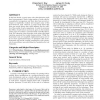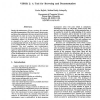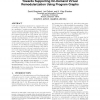126 search results - page 15 / 26 » Reverse engineering of object oriented code |
SEW
2006
IEEE
14 years 1 months ago
2006
IEEE
It is widely held that programming language extensions that support separation of concerns and that are also integrative benefit development, maintenance and reuse of software de...
C3S2E
2008
ACM
13 years 9 months ago
2008
ACM
In the last decade, a great many code clone detection tools have been proposed. Such a large number of tools calls for a quantitative comparison, and there have been several attem...
ICSM
1996
IEEE
13 years 11 months ago
1996
IEEE
During the maintenance of legacy systems, the structure and the documentationofthe system usually deteriorates, and hence the maintenance becomesprogressively harder and harder. I...
AOSD
2006
ACM
14 years 1 months ago
2006
ACM
OOP style requires programmers to organize their code according to objects (or nouns, using natural language as a metaphor), causing a program’s actions (verbs) to become scatte...
SOFTVIS
2010
ACM
13 years 7 months ago
2010
ACM
Object oriented software development is designed to be modular, with code reuse being very common. When bugs are introduced, they can manifest themselves in one or more sections o...



